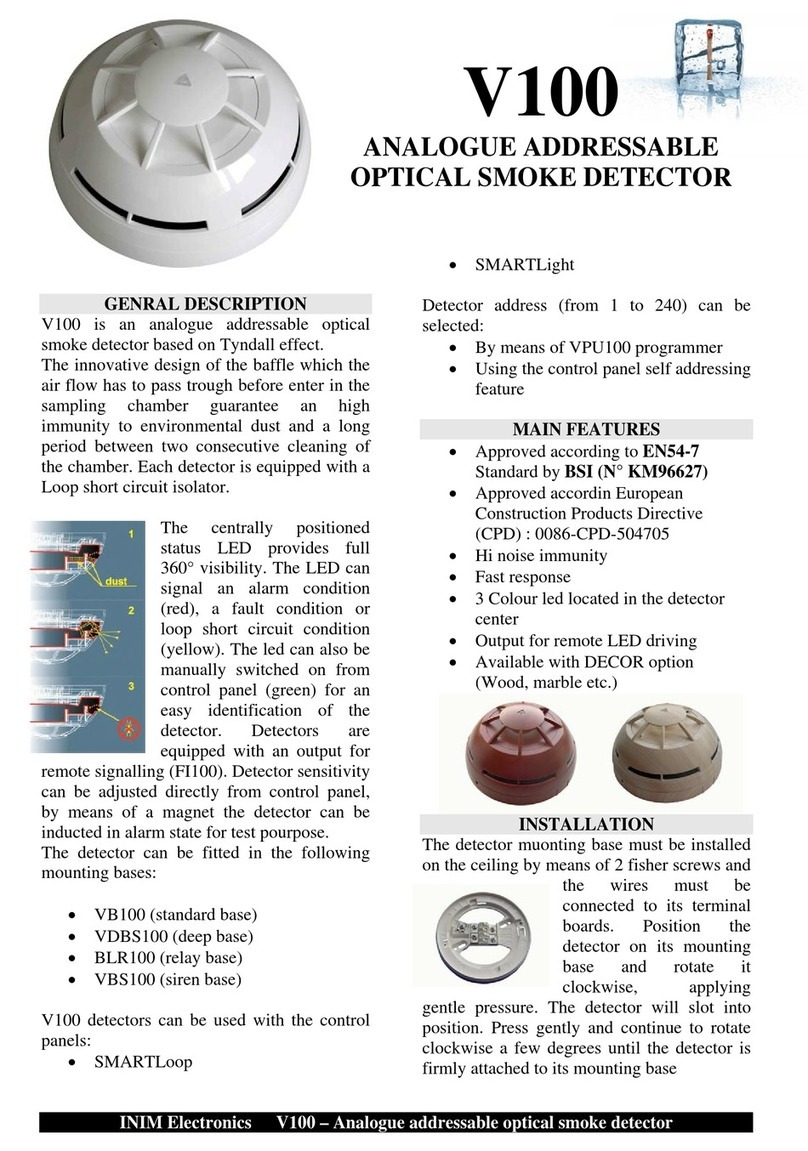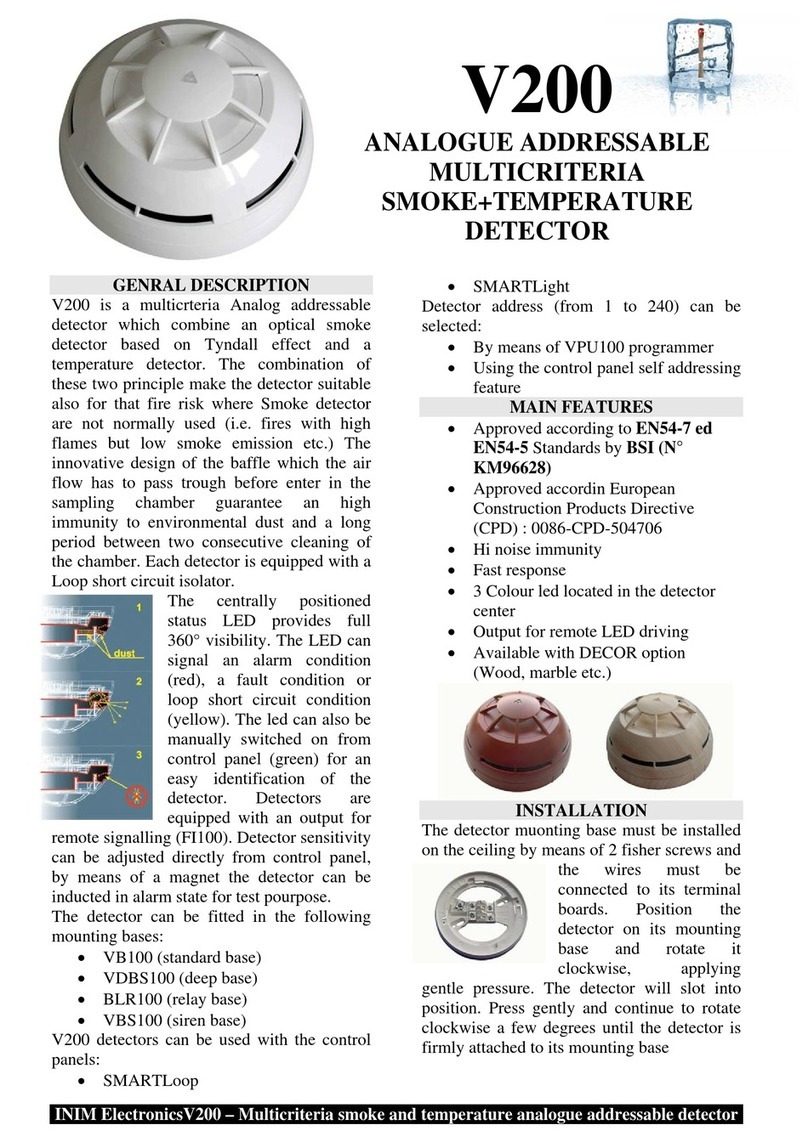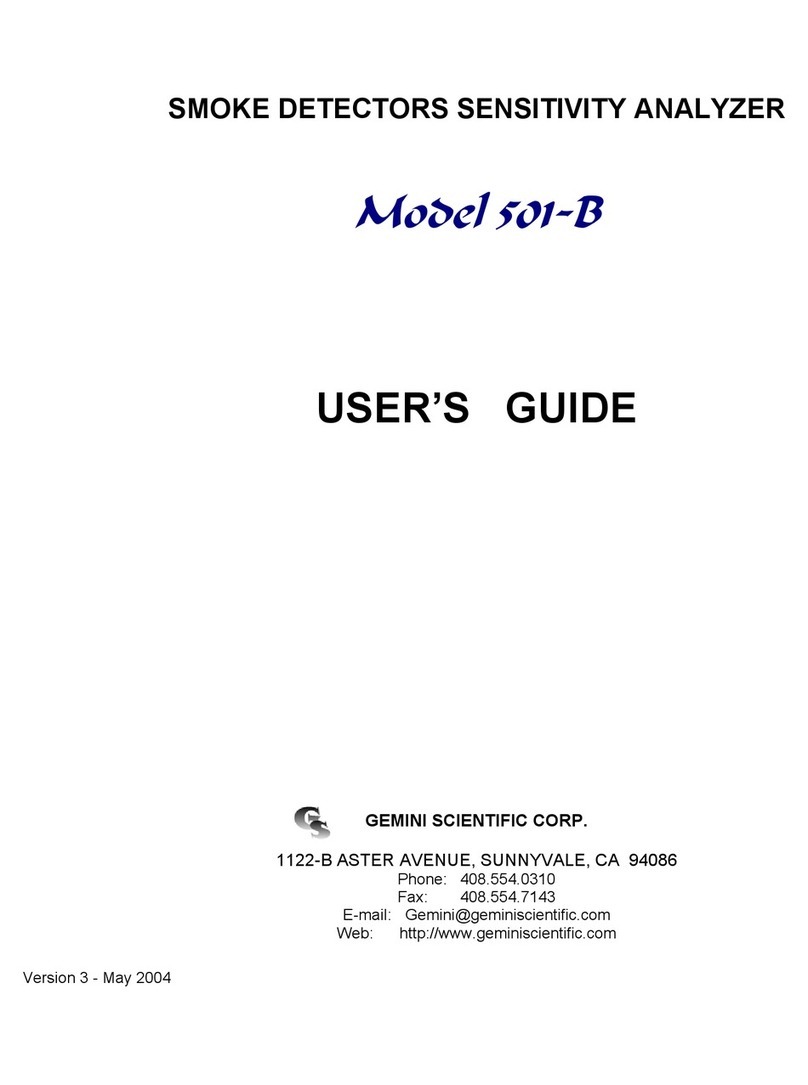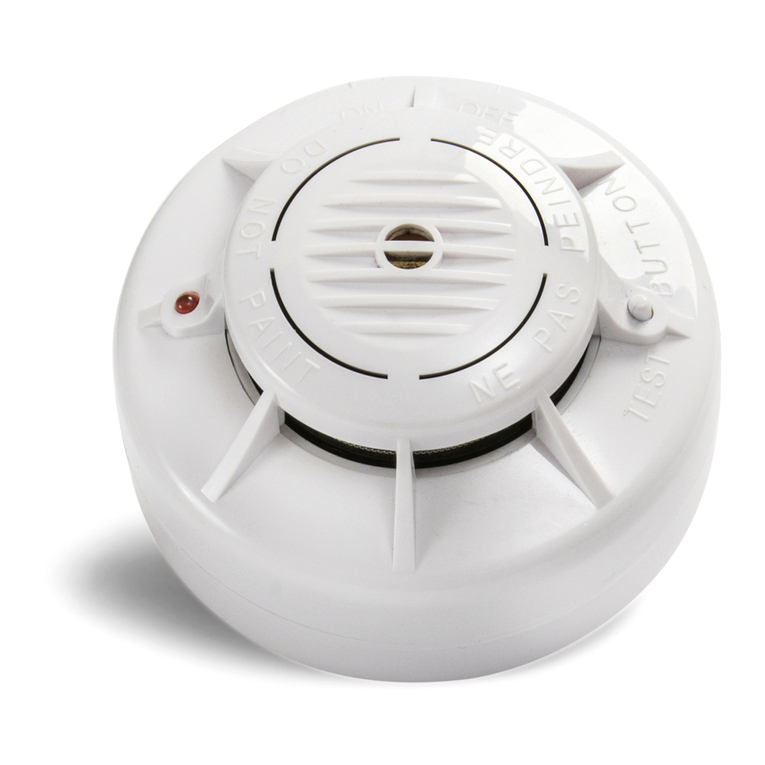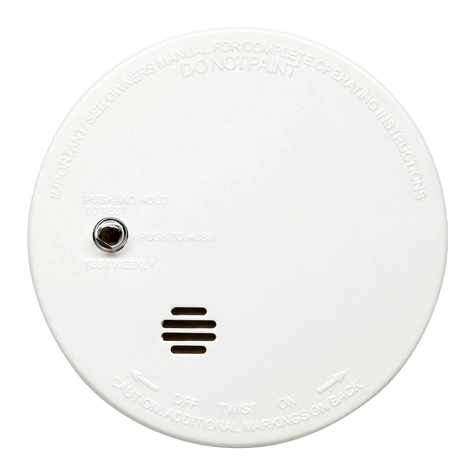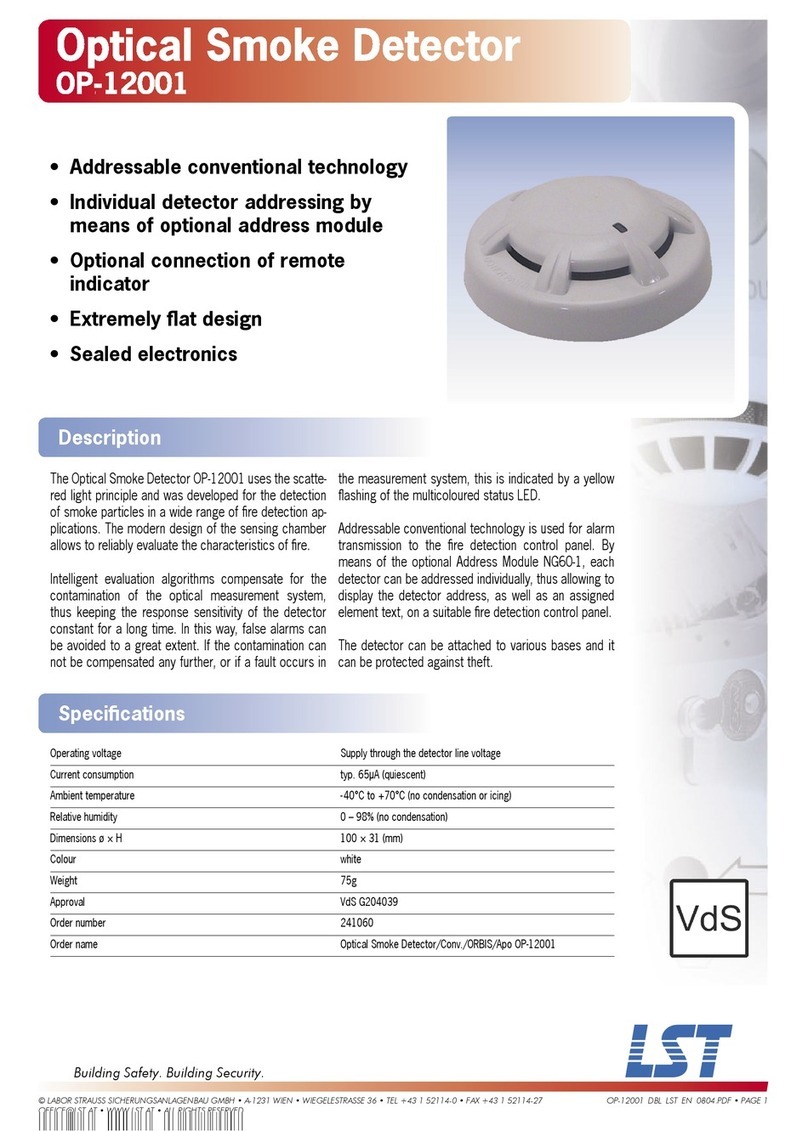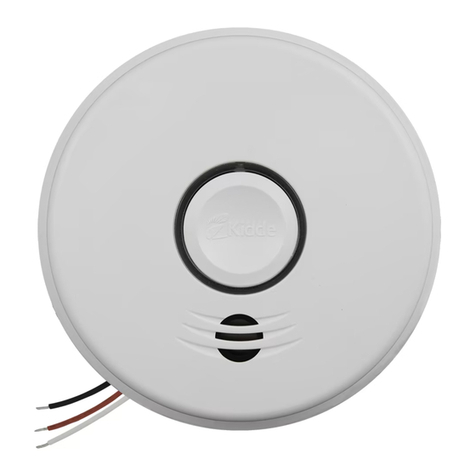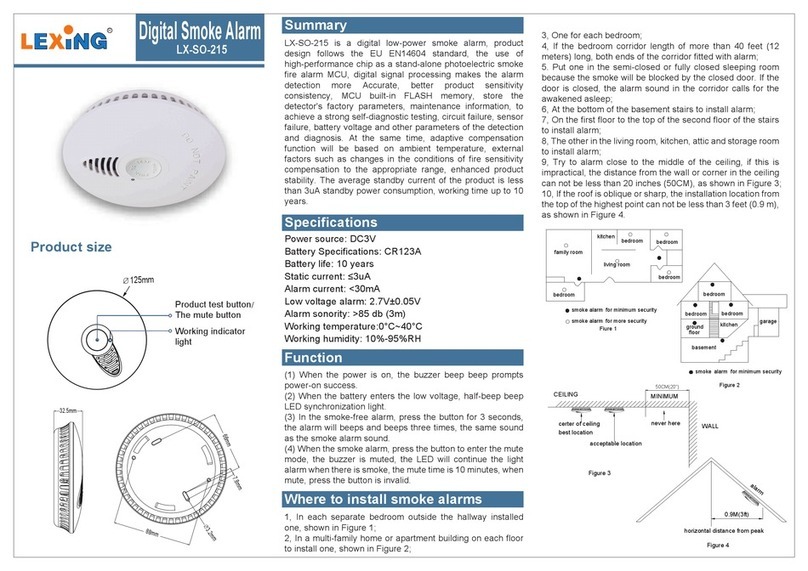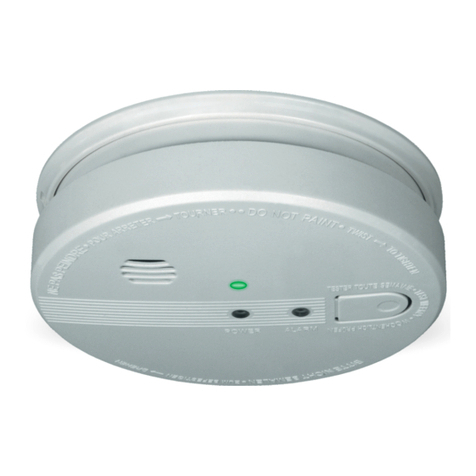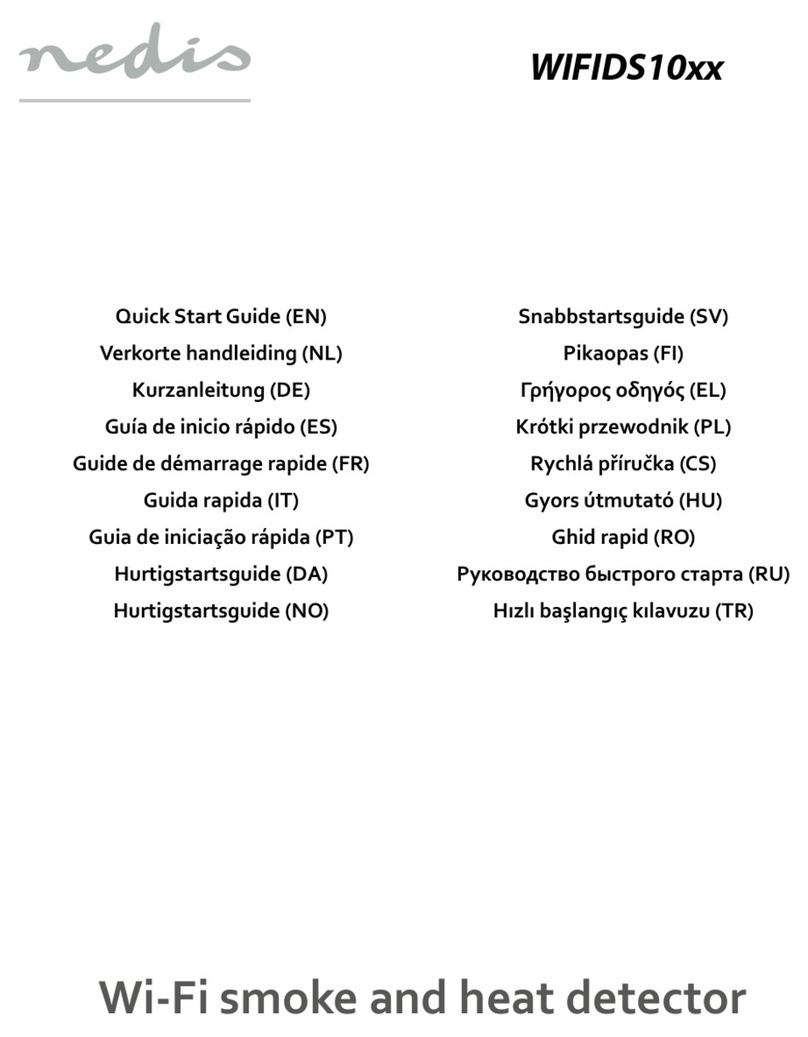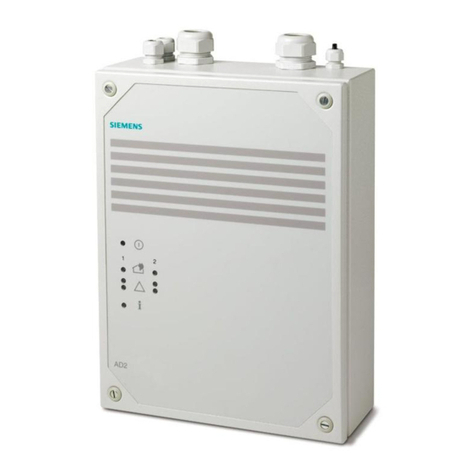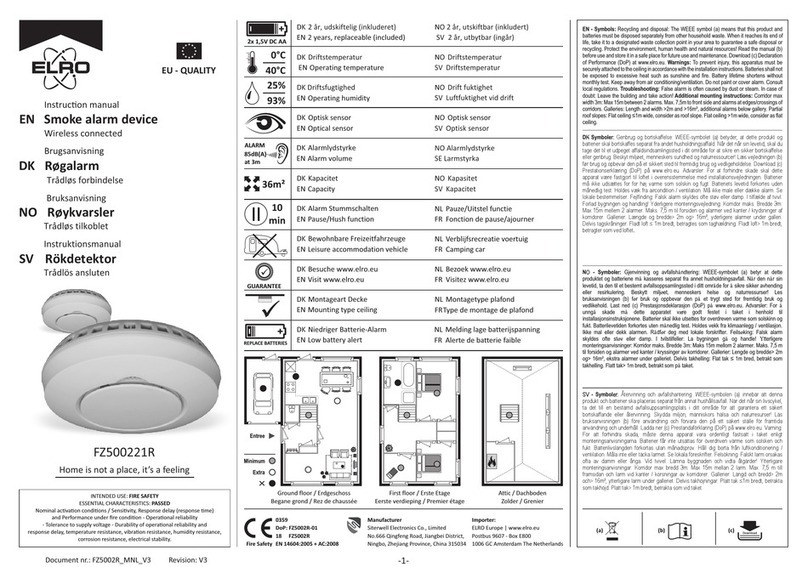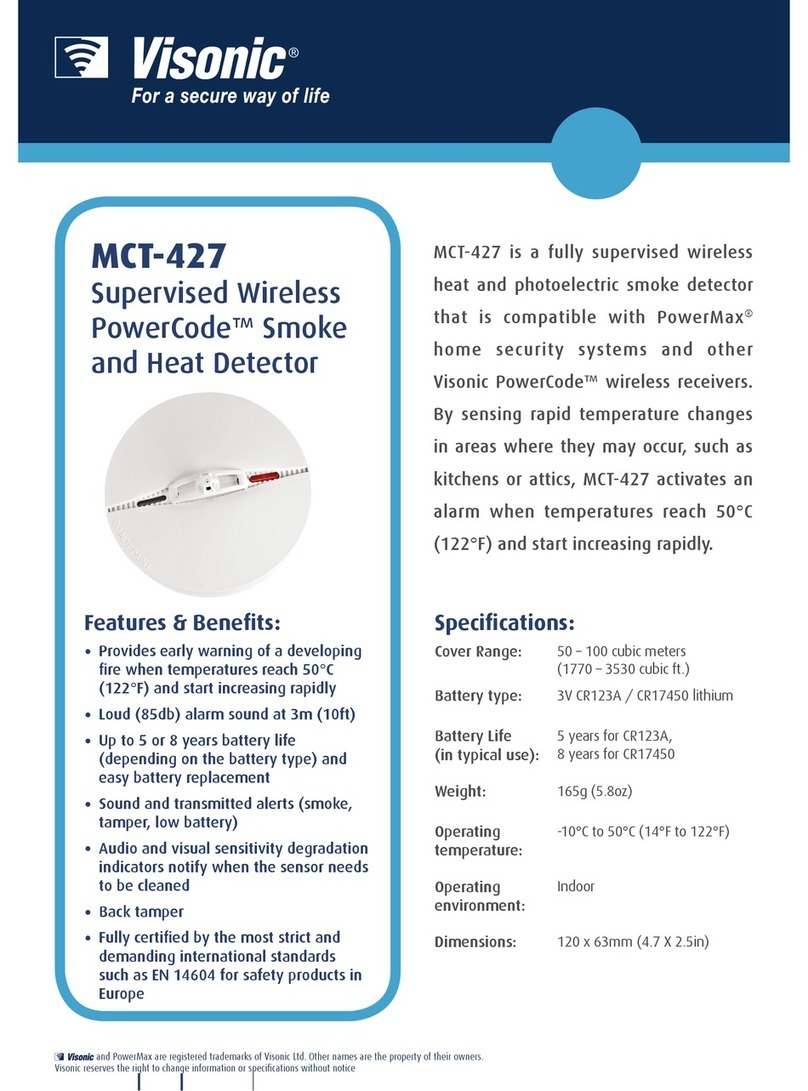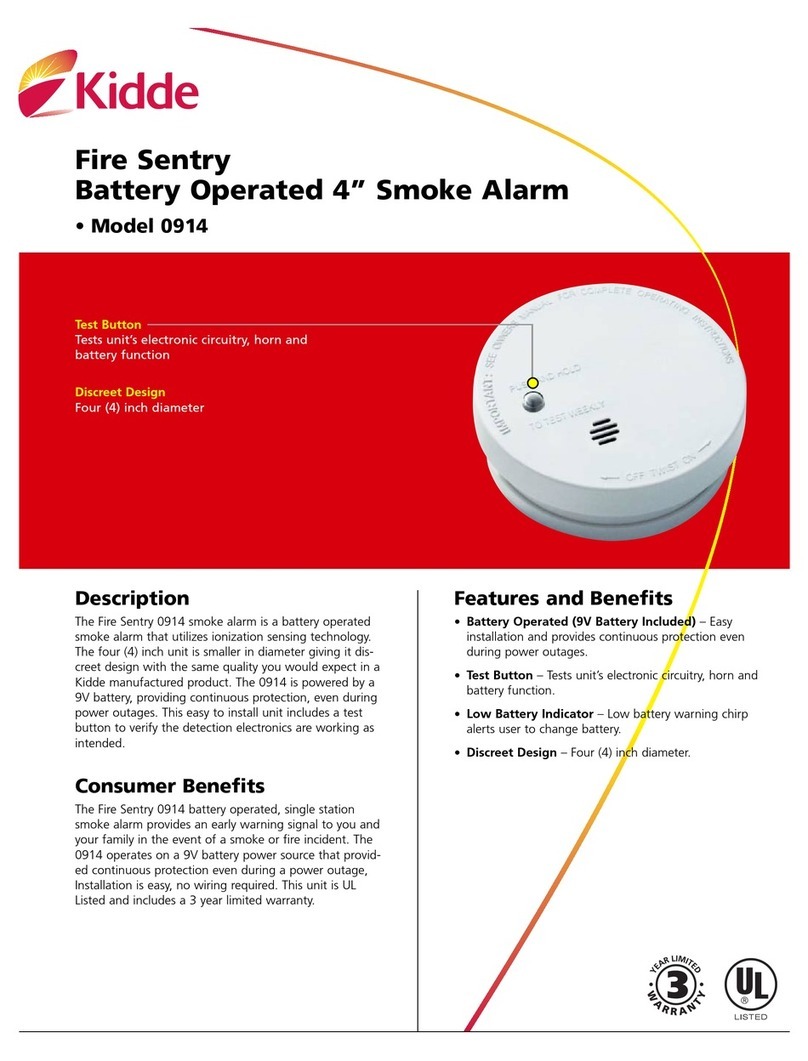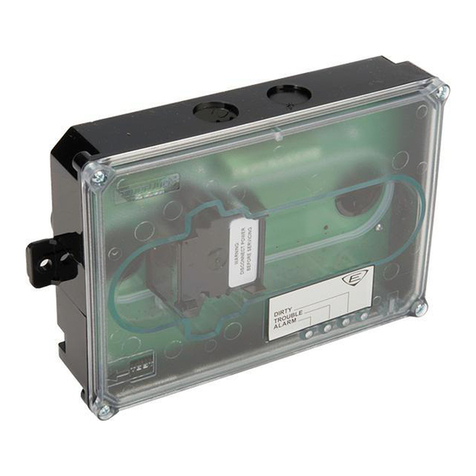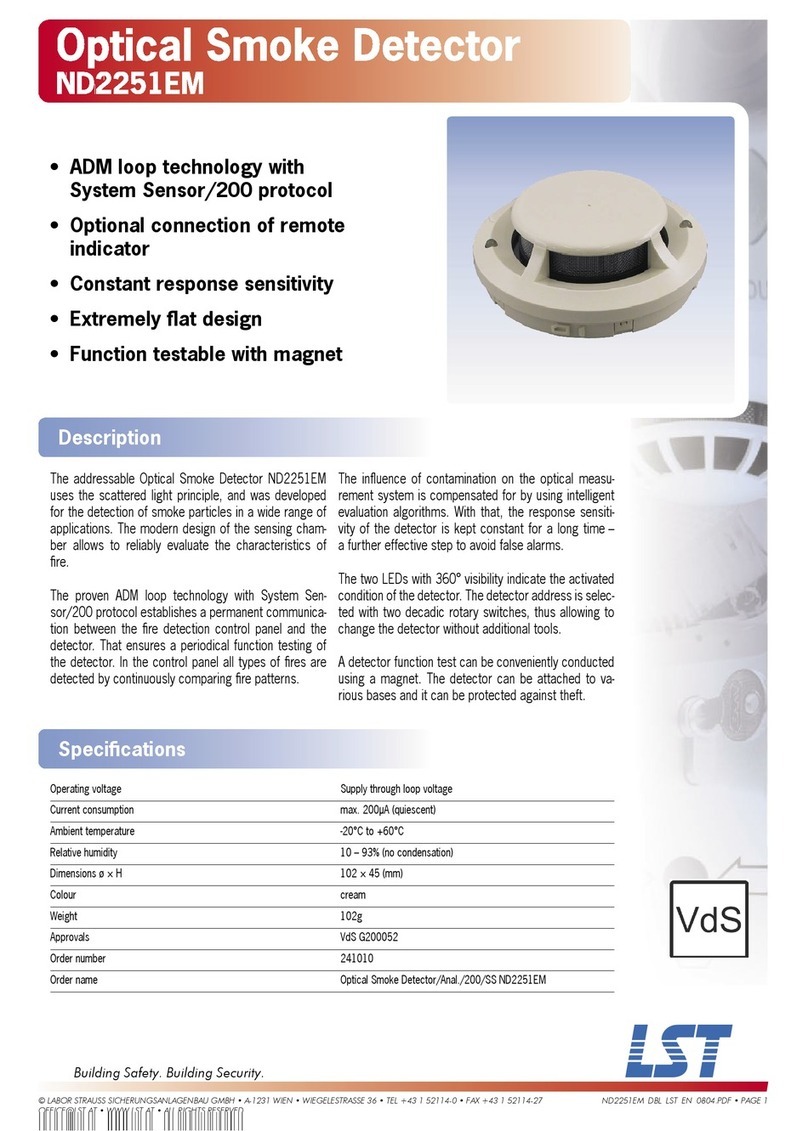INIM Electronics FireVibes WD100 User manual

GENERAL DESCRIPTION
The WD100 FireVibes series detector samples the air in the protected area; when the smoke quantity level exceeds a certain degree, a fi re
alarm message is sent to the control panel.
WD100 is battery powered and doesn’t need any system cabling installation.
WD100B is a black version of WD100. All pictures here below showing the white version are also valid for the black version.
LOCATION SELECTION
Select a location for the detector that conforms to your local applicable safety standards and that is in a good position for sending / receiving
wireless signals to / from the father EWT100, IWT100 or XWT100 network device.
Mount the detector as far as possible from metal objects, metal doors, metal window openings, etc. as well as cable conductors, cables
(especially from computers), otherwise the operating distance may greatly drop.
The WD100 must NOT be installed near electronic devices and computer equipment that can interfere with its wireless communication quality.
WD100
Wireless Optical Smoke Detector
DEPLOYMENT PROCEDURE
1) Select a location for the detector. See LOCATION SELECTION.
2) Unbox the detector from its packaging.
3) Detach the detector from its base. See INSTALLING / REMOVING THE DETECTOR.
4) Detach the battery cover from the detector. See BATTERY COVER.
5.1) a) Link the detector to the system (insulating tab extraction).
See LINKING - WAKE-UP - WITH INSULATING TAB.
See LINKING - ONE-BY-ONE - WITH INSULATING TAB.
-- or --
5.2) a) Power up the detector.
See POWERING UP - FIRST TIME USE - WITHOUT INSULATING TAB.
See POWERING UP - RECOVERY.
b) Link the detector to the system (moving the link program switch).
See LINKING - WAKE-UP - WITHOUT INSULATING TAB.
See LINKING - ONE-BY-ONE - WITHOUT INSULATING TAB.
6) Reinstall the battery cover on the detector. See BATTERY COVER.
7) Detach the identification tag from the base adapter. See IDENTIFYING THE DETECTOR.
8) Install the base adapter. See FIXING THE ADAPTOR BASE.
9) Install the detector on the base adapter. See INSTALLING / REMOVING THE DETECTOR.
10) Install the identification tag to the base adapter, with all relevant information written / labelled on it. See IDENTIFYING THE DETECTOR.
11) Secure the detector to its base with its safety anti-tamper screw. See INSTALLING THE SAFETY SCREW.
12) Test the detector. See TESTING.
It is advisable to use the EWT100-TESTER survey kit to
locate a good wireless installation location.
INIM ELECTRONICS S.R.L. VIA DEI LAVORATORI 10, FRAZIONE CENTOBUCHI, 63076 MONTEPRANDONE, ITALY
1) LED indicators
2) Battery A
3) Battery B
4) Link program switch
5) Tamper spring (internal)
6) Tamper switch (external)
7) Battery cover
8) Battery cover latch
9) Insulating tab
10) Wall fixing openings
11) Identification tag
12) Identification tag lodgement
13) Magnet test area
14) Base / detector reference marks
15) Safety screw
11234
5
Picture 1
Dust covers DO NOT provide
complete protection against
contamination: detectors
should be removed before construc-
tion, major re-decoration or other dust
producing work is started.
Dust covers MUST be removed before
the system can be made operational.
6
7
8
9
10 10
11
13
14
15
12
BATTERY COVER
Detach the battery cover by pulling and lifting the closing latch.
To reinstall the battery cover, insert its two hooks into their corresponding
detector’s recesses; then block it by pressing down the opposite side, until you
hear the click of the closing latch.
INSTALLING / REMOVING THE DETECTOR
Rotate the detector clockwise on its adaptor base to install it.
Rotate the detector anti-clockwise from its adaptor base to remove it.
IDENTIFYING THE DETECTOR
The detector can be visually identified by the detachable tag imprinted with the adaptor base.
1) Detach the tag from the base.
2) Write / label the relevant identification information on the tag.
3) Insert the tag into its lodgement on the side of the adaptor base.
FIXING THE ADAPTOR BASE
Fix the base to the wall with suitable screws.
INSTALLING THE SAFETY SCREW
Always install the safety blocking screw.
LED INDICATORS STATUS MESSAGES
The two LED indicators communicate to the final user the status of the WD100.
POWERING UP AND LINKING - PRELIMINARY NOTES
WD100 needs to be powered up with the supplied batteries.
Linking is the operation through which WD100 is “wirelessly connected” to a EWT100, IWT100 or XWT100 FireVibes network device.
LINKING - WAKE-UP - WITH INSULATING TAB
“Wake-up” linking consists in associating one or more child devices to the FireVibes system altogether in a single operation.
Wake-up is performed either through the FireVibes Studio software or the EWT100 / IWT100 keyboard-screen interface; it CANNOT be done
through XWT100 devices.
1) Create the “virtual model” of the WD100 either on FireVibes Studio or on the EWT100 / IWT100.
2) Pull out the insulating tab.
3) Trigger the wake-up procedure either from FireVibes Studio or from the EWT100 / IWT100.
4) Wait the end of the “wake-up” linking procedure.
5) Check on FireVibes Studio or from EWT100 / IWT100 for linking success. Consult their user manual.
LINKING - ONE-BY-ONE - WITH INSULATING TAB
“One-by-one” linking consists in associating one child device at a time to the FireVibes system.
This operation is performed either through the FireVibes Studio software or the EWT100 / IWT100 keyboard-screen interface; it CANNOT be
done through XWT100 devices.
1) Create the “virtual model” of the WD100 either on FireVibes Studio or on the EWT100 / IWT100.
2) Trigger the linking procedure either from FireVibes Studio or from the EWT100 / IWT100.
3) Pull out the insulating tab.
4) Wait the end of the “one-by-one” linking procedure.
5) Check on FireVibes Studio or from EWT100 / IWT100 for linking success.
Consult their user manual.
Always install the battery cover, since it is a vital
part of the tamper detection feature. Make sure
the battery cover is safely fixed, blocked and
closed. Make sure that the internal tamper spring fits
completely into its battery cover’s lodgement. Check,
more than once, that the cover’s external tamper switch
clicks when pressed.
When extracting the insulating tab, keep both
batteries into their lodgements with your thumb,
since they can be accidentally pulled out too.
2
Check the alignment of the raised reference
marks on the detector and on the base.
Always install the safety blocking screw.
Table 1
Please mind that LED signalling burns out battery
power, therefore reducing batteries lifespan.
Device status LEDs indication
Power up (DIP on “ON”) Blinks red 4 times
Power up (DIP opposite “ON”) Blinks green 4 times
Entering wake-up mode Blinks alternatively green / red 4 times
Link success (one-by-one) Blinks green 4 times, then the same pattern again
Link failure (one-by-one) Enters wake-up mode and signals “Entering wake-up mode” following this failure
Link success (wake-up) Blinks green 4 times, then same pattern again
Link failure (wake-up) Blinks green 4 times, then blinks red on once, then blinks alternatively green / red 4 times
Normal condition LED off (can be programmed so as to blink green every wireless communication)
Alarm activation Blinks red every 2 seconds
Battery fault LED off (can be programmed so as to blink amber every 5 seconds)
Tamper fault LED off
Replaced Blinks amber 2 times
Test mode active Blinks green

POWERING UP - FIRST TIME USE - WITHOUT INSULATING TAB
Use this procedure the first time you power up a WD100; the detector has not been supplied with the insulating tab.
1) Make sure the Link / program switch is set on “ON”.
2) Insert the two supplied batteries into their device’s lodgments.
POWERING UP - DEVICE LINKED TO THE SYSTEM
Use this procedure when a WD100 is successfully linked to its FireVibes system and you have to extract one or both batteries (e.g. batteries
substitution).
1) Reinsert the battery or both batteries into their lodgments.
If performing a batteries substitution, use two brand new batteries and substitute both of them.
Do not touch the Link / program switch.
POWERING UP - RECOVERY
Use this procedure when you fail to link successfully a WD100 or you want to link it again.
1) Move alternatively the Link / program switch 5 times.
2) Set the Link / program switch on “ON”.
3) Insert the two supplied batteries into their device’s lodgments.
LINKING - WAKE-UP - WITHOUT INSULATING TAB
“Wake-up” linking consists in associating one or more child devices to the FireVibes system altogether in a single operation.
Wake-up is performed either through the FireVibes Studio software or the EWT100 / IWT100 keyboard-screen interface; it CANNOT be done
through XWT100 devices.
1) Create the “virtual model” of the WD100 either on FireVibes Studio or on the EWT100 / IWT100.
2) Power-up the detector (either “first time use” or “recovery”).
3) Set the Link / program switch OPPOSITE to “ON”.
4) Trigger the wake-up procedure either from FireVibes Studio or from the EWT100 / IWT100.
5) Wait the end of the “wake-up” linking procedure.
6) Check on FireVibes Studio or from EWT100 / IWT100 for linking success. Consult their user manual.
LINKING - ONE-BY-ONE - WITHOUT INSULATING TAB
“One-by-one” linking consists in associating one child device at a time to the FireVibes system.
This operation is performed either through the FireVibes Studio software or the EWT100 / IWT100 keyboard-screen interface; it CANNOT be
done through XWT100 devices.
1) Create the “virtual model” of the child device either on FireVibes Studio or on the EWT100 / IWT100.
2) Trigger the linking procedure either from FireVibes Studio or from the EWT100 / IWT100.
3) Power-up the child device (either “first time use” or “recovery”).
4) Set the child device’s Link / program switch OPPOSITE to “ON”.
5) Wait the end of the “one-by-one” linking procedure.
6) Check on FireVibes Studio or from EWT100 / IWT100 for linking success. Consult their user manual.
TESTING
Magnet test
1) Activate test mode.
2) Apply again the magnet in correspondence of the “magnet test activation area”.
3) LED indicators signal “Alarm activation”.
Aerosol test
1) Activate test mode.
2) Apply the aerosol test device to the detector.
3) Wait a few seconds.
4) LED indicators signal “Alarm activation”.
BATTERY FAULTS AND BATTERY SUBSTITUTION PROCEDURE
When one or both batteries are low in charge, a specific fault message is routed to the
control panel. If such event occurs:
1) Remove the safety screw.
2) Remove the detector from its base.
3) Remove the batteries cover.
4) Extract both batteries.
5) Insert both new batteries into their holders, oriented as per polarity marks.
See POWERING UP - DEVICE LINKED TO THE SYSTEM.
6) Reinstall the batteries cover.
7) Reinstall the detector.
8) Reinstall the safety screw.
Local safety standards may require you
to test these devices on a regular basis.
Use only suitable aerosol testers supplied by
approved manufacturers. Follow their specific
use instructions.
Before testing every WD100, always
activate test mode. This is done by
holding a suitable magnet in the
“magnet test activation area”. When activated,
LED indicators signal “Test mode active”.
When a low battery condition is indicat-
ed, both batteries must be changed
altogether.
Batteries must be brand new.
Do not touch the Link / program switch.
Ensure that the batteries are installed properly,
with their polarities matching the indications on
the device.
Always ensure that the batteries are
installed properly, with their polarities
matching the indications on the device.
INIM ELECTRONICS S.R.L. VIA DEI LAVORATORI 10, FRAZIONE CENTOBUCHI, 63076 MONTEPRANDONE, ITALY www.inim.biz
3
MAINTENANCE - CLEANING
1) Remove the safety screw.
2) Remove the detector from its base.
3) Smoke entry areas: use a small, soft bristle brush to dislodge any obvious contaminants such as insects, spider webs, hairs, etc.
4) Smoke entry areas: use a small vacuum tube or dry, clean, compressed air to suck up or blow any remaining small particles away.
5) Wipe the exterior housing of the detector with a clean, damp, lint-free cloth to remove any surface film that can later attract airborne
contaminants.
6) Install the detector onto its base again.
7) Test the detector.
8) Reinstall the safety screw.
TECHNICAL SPECIFICATIONS *
*See TDS-TWDOX technical specification document for further technical data.
BATTERIES SPECIFICATIONS
*Batteries lifespan depends by environmental conditions, default monitor settings and link quality.
SMOKE SENSITIVITY SPECIFICATIONS
*Detector’s smoke sensitivity can be set through FireVibes Studio .
Specification Value
Communication range with EWT100, IWT100 or XWT100 network
devices 200 m (in open space)
Wireless frequency band(s) of operation 868-868.6 MHz, 868.7-869.2 MHz, 869.4-869.65 MHz, 869.7-870.0 MHz
Number of wireless channels 66
RF output power (max) 14 dBm (25 mW) e.r.p.
Operating temperature range -10 °C to 55 °C
Maximum humidity (non condensing) 95% RH
IP rating 40
Specification Value
Batteries type CR123A (3 V, 1.25 Ah)
Batteries lifespan * 10 years
Low battery threshold value (nominal) 2.850 V
Detector’s sensitivity setting * Obscuration threshold value for alarm activation
High sensitivity 0.12 dB/m
Medium sensitivity (default setting) 0.15 dB/m
Low sensitivity 0.18 dB/m
Table 2
Table 3
Table 4
WARNINGS AND LIMITATIONS
Our devices use high quality electronic components and plastic materials that are highly resistant to
environmental deterioration. However, after 10 years of continuous operation, it is advisable to replace
the devices in order to minimize the risk of reduced performance caused by external factors. Ensure
that this device is only used with compatible control panels. Detection systems must be checked,
serviced and maintained on a regular basis to confirm correct operation. Smoke detectors may respond
differently to various kinds of smoke particles, thus application advice should be sought for special
risks. Detectors cannot respond correctly if barriers exist between them and the fire location and may
be affected by special environmental conditions. Refer to and follow national codes of practice and
other internationally recognized fire engineering standards. Appropriate risk assessment should be
carried out initially to determine correct design criteria and updated periodically.
Use only in FireVibes fire detection and alarm systems.
WARRANTY
All devices are supplied with the benefit of a limited 5 years warranty relating to faulty materials or
manufacturing defects, effective from the production date indicated on each product. This warranty is
invalidated by mechanical or electrical damage caused in the field by incorrect handling or usage.
Product must be returned via your authorized supplier for repair or replacement together with full
information on any problem identified. Full details on our warranty and product’s returns policy can be
obtained upon request.
[email protected] DCMIINE0WD100-120
4
INIM ELECTRONICS S.R.L.
VIA DEI LAVORATORI 10
FRAZIONE CENTOBUCHI
63076 MONTEPRANDONE (AP)
ITALY
EN 54-7:2018
EN 54-25:2008
WD100
WD100B
Wireless Optical Smoke Detector for fire
detection and fire alarm systems
installed buildings
Level or class of the performance per
each essential characteristic can be
found in the Declaration of Performance
0051
22
0051-CPR-2765
Other INIM Electronics Smoke Alarm manuals

